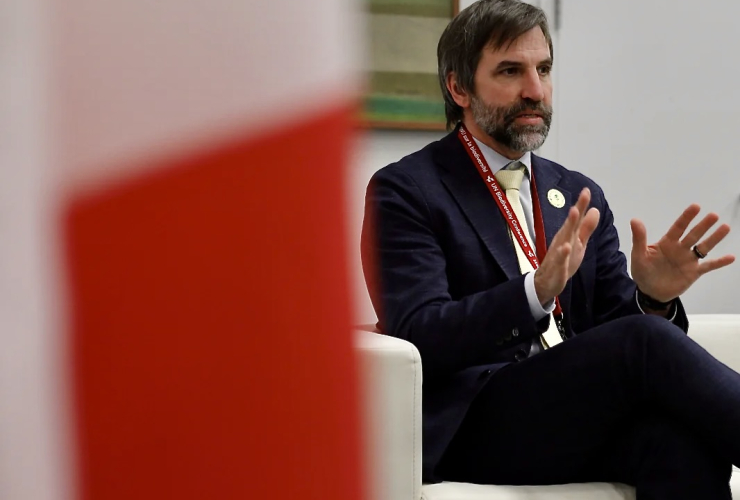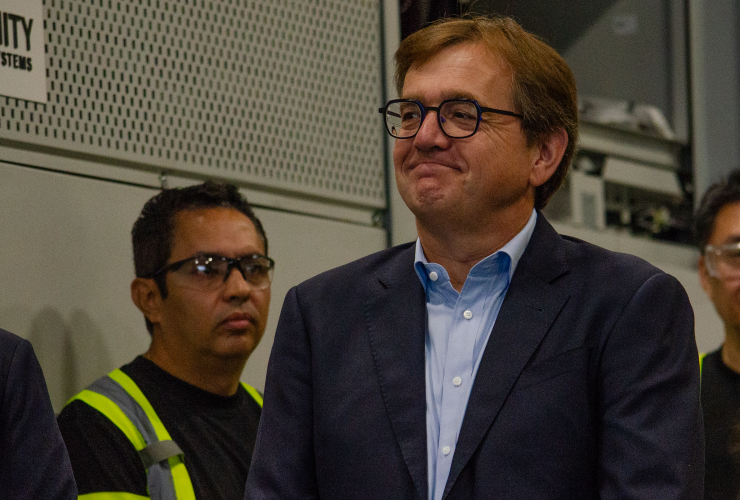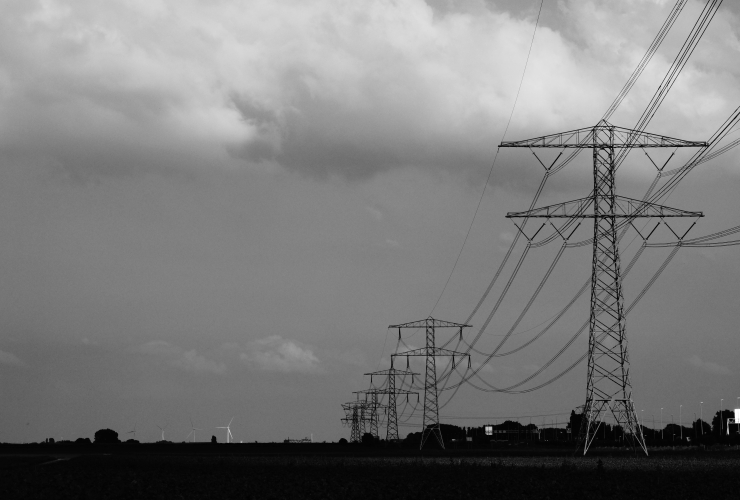As the McMahon Stadium crowd waited for the kickoff of the Labour Day Classic, a Canadian Football League tradition, Calgary was shrouded in a thick smoke reminiscent of the smoggy coal town in Charles Dickens's novel, Hard Times.
The Air Quality Index was nine out of 10, hovering close to the very high-risk classification that might have caused the game to be cancelled. The amount of smoke in Calgary had just hit a record of 464 hours and counting — in a city that used to boast about its clean air and saw only 12 hours of smoke per summer.
Wildfires and evacuations are a constant reminder that climate change is having a negative impact on our environment and our lives. As the vast majority of climate scientists have predicted, air quality, heat and water shortage advisories are also on the rise.
Despite the dramatic changes to Calgary’s climate in just the last 10 years, many Albertans still struggle to accept the following statement from the United States Environmental Protection Agency: “Burning fossil fuels changes the climate more than any other human activity.”
An inability to accept the immediate need for transitioning to a cleaner global energy system creates a mindset that opposes renewable energy and redoubles support for a polluting industry that no longer has a promising future.
Albertans should be embracing the diversification provided by investment in renewable energy but, instead, our province is blocking community-led solar projects that will ultimately help reduce the impacts of climate change. At the same time, our government inequitably subsidizes fossil fuel corporations that are already profitable and mostly foreign-owned.
In Alberta and other Canadian provinces, the electricity system relies on baseload generators and reserve capacity designed to quickly add power during periods of peak demand or unexpected outages.
A recent grid alert in Alberta was the result of lost baseload capacity from natural gas generators combined with planned maintenance on the transmission lines interconnecting with British Columbia.
Premier Danielle Smith attempted to use the incident to falsely blame wind energy, despite the fact these grid alerts are infrequent and can generally be handled without any disruptions to Alberta’s power system.
According to the Alberta Electric System Operator’s (AESO) communications manager Leif Sollid, grid alerts can be resolved by “calling on Alberta-based generators to increase supply if possible; cancelling any transmission line maintenance that is hindering supply; suspending exports of electricity; requesting an increase in emergency imports from B.C., Montana and/or Saskatchewan; exercising voluntary load curtailment with large industrial customers with whom we have contracts to take this action; and making a public appeal via social media for Albertans to conserve energy.”
Despite AESO successfully integrating and managing rapidly growing renewable energy inputs, opponents of wind and solar power repeatedly question its reliability. Will Alberta’s electricity grid become unreliable as more renewable generating capacity is added?
Denmark has already answered this question with an electricity system that uses wind and solar energy to supply 60 per cent of the country’s electricity consumption. In Alberta, renewable sources currently supply about 17 per cent.
The key to Denmark’s success was building transmission lines that facilitate the export of electricity to neighbouring European Union countries. Wind and solar capacity can exceed Danish consumption with the added value of selling surplus electricity to external markets.
The Danes are also innovating to improve the capacity of their electrical system. Dynamic Line Rating is used to squeeze additional power over, depending on weather conditions. This way, more power can be delivered at night or on colder days.
Exporting electricity can be lucrative. When windy conditions make excess electricity, it can be sold to interconnected neighbours where local electricity costs are higher.
For example, the North Sea Link between Norway and the United Kingdom is the longest high-voltage, direct-current transmission line in the world. It allows cheaper U.K. wind energy to be sold to Norway when local natural gas prices are high or hydropower reservoirs are low. Conversely, Norway’s hydroelectricity can be sold to the U.K. when reservoirs are full and prices are low.
Denmark is completing its own transmission line to the U.K. later this year. Jesper Rasmussen of Energinet, Denmark’s electricity transmission system operator, explains, “Denmark has historically, due to its geographical place between the Nordic hydro-based power system and central Europe’s thermal systems, been a transit country with lots of import and export.”
A well-functioning EU power market allows Denmark to act as an electricity hub and creates an opportunity to sell Danish renewable electricity into much larger EU markets.
Alberta’s interconnection capacity includes an 800-megawatt (MW) intertie to British Columbia, 300 MW to Montana and 150 MW to Saskatchewan. The lack of a larger network of interconnections is a lost opportunity for Alberta to create wealth and jobs from its abundant wind and solar resources.
During peak hours, Denmark’s electricity consumption is approximately six gigawatts (GW), or about half of Alberta’s peak consumption. Danish interconnect lines can export/import up to 7.5 GW between other countries with the new U.K. interconnect adding another 1.4 GW of capacity and a new market.
Import capacity already exceeds Danish electricity consumption and over the next decade, renewable generating capacity will also greatly exceed domestic consumption. Denmark’s grid is stabilized by an abundance of generating capacity and interconnection options while trading excess capacity provides ongoing economic benefits.
Alberta has a long way to go. Interconnection capacity would have to increase tenfold and renewable generation more than triple to match the ambition of Denmark’s electricity system.
A report by the Pembina Institute stresses that a decarbonized grid is key to unlocking future economic opportunities in Alberta. It states, “We find that electricity exports soar with growth of renewables and increasing provincial export capacity, achieved through expansion of transmission connections to other jurisdictions (interties).”
Would it make sense for Alberta to export renewable energy to Montana where coal generates 42 per cent of the state’s electricity?
In Washington state, the Grand Coulee Dam produces 21 million megawatt hours of electricity each year and supplies eight western states and parts of Canada but recently, drought conditions have severely drained reservoirs in the West, creating conditions where cheaper electricity imports might be a welcome relief for strained hydro resources.
Transitioning to an energy system for the future is possible and well underway. Pattern Energy recently announced SunZia, a $10-billion wind farm and transmission line project between renewables in New Mexico and the electricity grid in Arizona. It is the largest clean-energy infrastructure project in U.S. history and is only a fraction of the cost of Canada’s Trans Mountain pipeline expansion project.
Projects like SunZia and the booming wind and solar industry in Alberta are clear indicators that energy investors in North America are watching how the EU and China are evolving their electricity grids. This is the future of energy infrastructure. Canada’s oil and gas pipelines are destined to become relics of yesterday’s global economy.
Alberta is sitting on the world’s fourth-largest oil reserve and it is understandable that it will be difficult for people to accept that the oilsands won’t continue generating ever-increasing heaps of wealth.
We have to acknowledge the amount of change that is occurring right now — both in terms of worsening climate conditions and a global energy transformation. Failing to prepare Alberta’s economy and electricity system for a cleaner future is a recipe for wealth destruction and smoky skies.
Rob Miller is a retired systems engineer, formerly with General Dynamics Canada, who now volunteers with the Calgary Climate Hub and writes on behalf of Eco-Elders for Climate Action.
Excellent and informative
Excellent and informative article; thank you.
The interdependence or "interties" you mention are an example of what's most desperately needed now, which is collaboration; that and "the market," the additional value of which has been to seriously weaken conservative credibility as the ones to trust with "the economy." This has also served to expose their true motivations and underpinnings.
Since two thirds of Albertans don't agree with the moratorium on renewables and Doug Ford has had to back down on business as usual, we may finally have these charlatans on the ropes.
And speaking of motivations and/or underpinnings, along with the growing public awareness of political CULTS like MAGA and QAnon, why isn't more media talking about "Take Back Alberta?"
Is TBA not proof positive that our Canadian zeal for "tolerance" has fully enabled "true believers" and their inescapably alternate reality to proliferate to the point that a religious cult now dictates our politics at the highest level?
Theocracies uniformly present an ongoing cautionary tale and a stark, often horrifying contrast to where our modern society IS now, so we truly need to remind ourselves that their guiding premise is one of those rigid religious doctrines that we take such irrational Canadian pride in "tolerating" despite their equally proud and irrational INtolerance?
Is it not ever more obvious that we have to actively reinstate secularism by rooting religion out of public life, which begins by exposing its shadowy albeit overweening presence there? Clearly it should only be allowed in private life; it is after all undeniably and primarily imaginative.
The current climate of burgeoning human rights serves to remind us that we are ALL human, but we are NOT all religious; increasingly quite the contrary in the west, making a showdown inevitable anyway.
Check out an essay published
Check out an essay published in the New York Review of Books..Jun 1995. By Umberto Eco, who lived through Mussolini's fascism as a boy......I think you'll be shocked by how many characteristics of what he calls Ur Fascism fit theTBA crowd.
The one I'm most struck by is 'Disagreement is Treason'...........they're so rigid in their ideas and beliefs that criticism or disagreement is intolerable. There are other boxes in Eco's 14characteristics our 'freedom lovers' tick as well
See what you think. I believe we're in much more dangerous times than most of us imagine....absolute ideas are bad in themselves, but when they are cooked up by the likes of the mob that went up to Edmonton after the Notley government was elected.......planning a kudetat (which they claimed as the English spelling)....by mass rally, we're all in more trouble than we may realize. And religion is implicated, but it goes beyond religion...no one has 'human rights' but them.
Read the opening paragraphs
Read the opening paragraphs but don't subscribe so....but I get the drift, like what he said about learning that freedom can be seen as freedom from rhetoric instead of being expected to memorize Mussolini's or anybody else's speeches or doctrine of ANY kind for that matter,
Imagine what a relief it would be to simply be fellow creatures on the planet as John Lennon sang.
There's definitely a pattern there-- stirring high emotion around tribal belonging that's apparently SO compelling to so many. I assume that these people are extroverts, always looking around for their team members?
NOT being one of those I've never really understood that but see that and the drive for competition as what may well do us in because it's such an adrenaline rush, so is addictive. In that context sports are obviously the acceptable escape valve on which massive sums are spent and attention paid but whatever works because when you look at what's going on around the world where the tribal thing is most out of hand with some religion or other or some minor variable of ethnicity there's constant war; it's like all those type of men want to do is fight, period. "Guys gotta grapple" as the owner of a gym stated during the pandemic shutdown.
I agree with you Mary that we may be in more dangerous times than we realize, but also maintain that the big lie of religion uniquely inspires insane acts like no other, I mean, if you believe it, it seems to invade your very consciousness to make you feel watched and paranoid. Listen to Arabs when they talk on the news; they mutter "god willing, god willing" over and over compulsively. It's far from benign either, and almost always shows up alongside the legions of egomaniacal men as their validation. And it is always men.
But it's in a class by itself, and is particularly crazy when it manifests in fresh, new versions like QAnon where "Q" is the omniscient being of choice. It's batshit, all of it, and dangerous as hell.
Yes, have read a lot about
Yes, have read a lot about fascism since moving to Alberta as a senior. Am very concerned about TBA, and the UCP itself! Poilievre himself is also moving there. Anything said or done by the Liberals is unacceptable and his constant haranguing is very convincing to our youth.
A national smart grid could
A national smart grid could do everything Denmark is doing in terms of power transmission management. Balancing power between local jurisdictions and provincial grids and storing excess power in mass battery packs, supercapacitors and pumped hydro would bring tremendous flexibility and affordability across the country. Along with that comes the capability to import / export electricity long distances in milliseconds and build up the nation's industrial base without increasing emissions.
Is there something wrong with that, Danielle & Pierre?
To the east, and to the south
To the east, and to the south, Alberta can only sell power to people with the same landscape and power-generation possibilities.
When we get the weather we got last Dec 20-26, with almost no sun and almost no wind, plus -30C for an extra challenge, the problem for all of North America is to power the prairie provinces and states that all lost wind and solar generation at the same time.
It's a continental problem, to bring in more power at those times from the hydro to east and west. Manitoba and BC have hydro, but can also produce wind and solar, can therefore save up their hydro for when the whole middle of the continent needs it.
Last Dec 22, Alberta was on 96% gas, about 12GW out of 12.5GW needed. That's despite a theoretical 20% capacity with wind, and 6% with solar. Both were running at 10% of their capacity, i.e. 2.6% of provincial needs out of 26% possible.
You can't beat that by just overbuilding capacity. The new 100-hour batteries from Form Energy may get you there, if you bought several billion dollars of them. But Alberta really needs to be able to hit BC up for a couple more gigawatts.
Indeed, Canada's legacy hydro
Indeed, Canada's legacy hydro makes for a good backup. But long range, glacier fed reservoirs will diminish in capacity as the glaciers disappear.
This is where geothermal needs to kick in, especially closed loop deep geothermal which has the most widespread generating potential of all forms of power known today. The tech is in its infancy and is more expensive than solar and wind, but that's no excuse to avoid developing it further today and having it ready and affordable by mid-century.
We need more articles like
We need more articles like this one in land locked, idea depressed Alberta. The future is sunny....increasingly so. But if we use those sun beams, and all that prairie free but irritating wind....we could actually be the pace centre for this clean electricity grid Smith fears...............let's git er done, as the boosters say.
And if we aren't completely finished with the project by 2035...at least we'll be further ahead, and with far less cost to the taxpayer, than we are with either the Site C boondoggle, or the Transmountain crown corporation. We haven't had a problem in the past with mega projects that go over budget and far past the promised end date.
This clean transition sounds a lot more doable, and far more profitable than crazy ideas like Carbon Capture or Small modular nukes. Let's get on it.






Comments